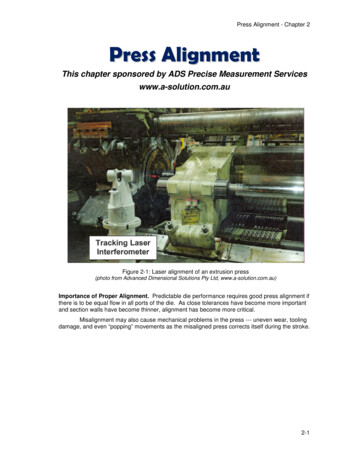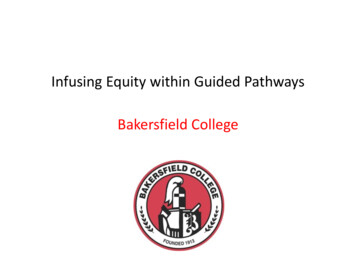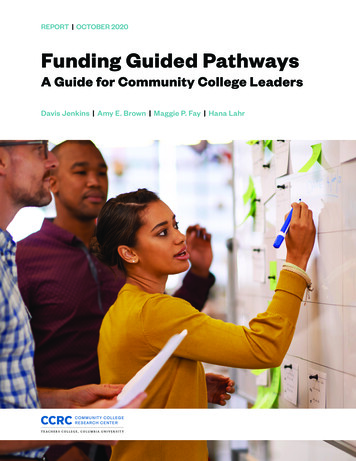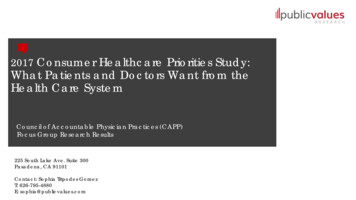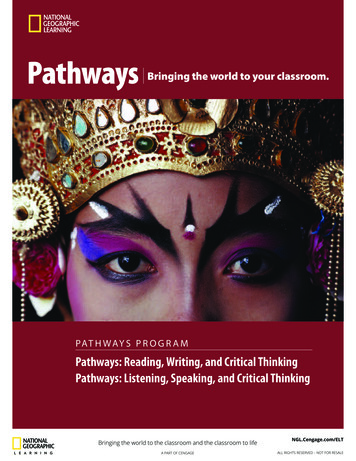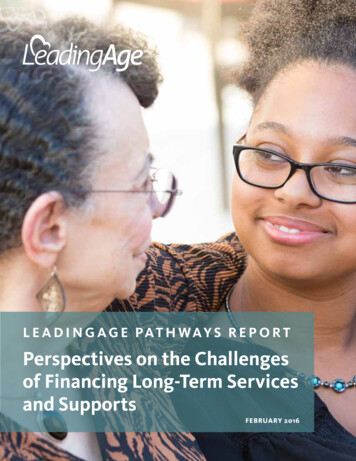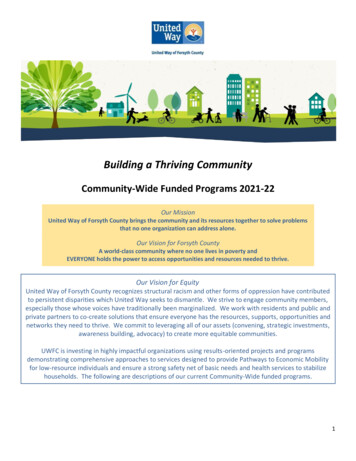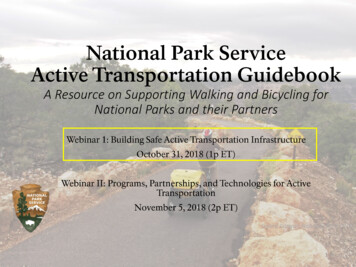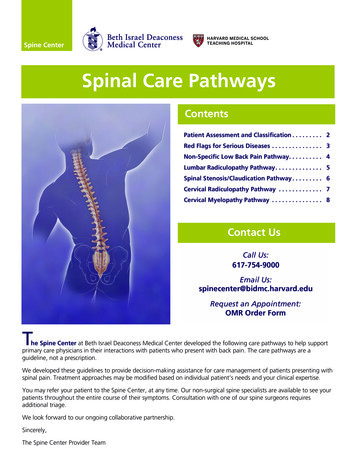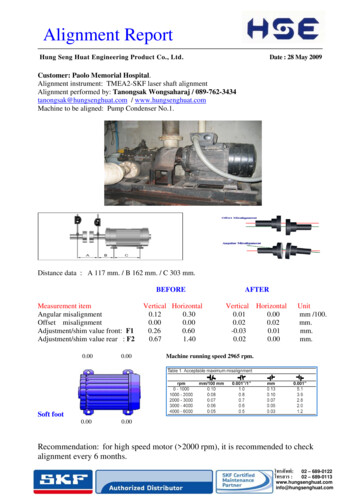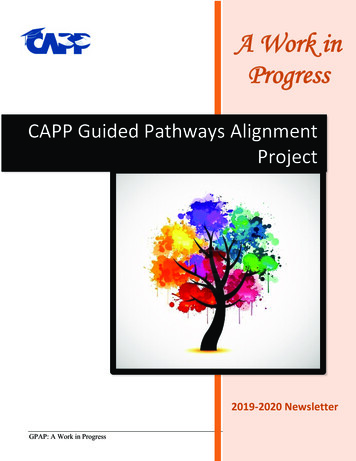
Transcription
A Work inProgressCAPP Guided Pathways AlignmentProject2019-2020 NewsletterGPAP: A Work in Progress1
Guided Pathways Alignment Project (GPAP): A Work in ProgressContextCalifornia educational segments acknowledge they often work in silos, separated and isolatedfrom one another, and recognize that significant improvement in K-20 education requires intersegmental coordination. This coordination depends upon, not just good will and intentions, butpersistent effort over time. Even in K-20 collaborations with a shared vision and the political will,implementation requires individuals in multiple roles to expand their boundaries and lookbeyond the history and culture of their respective institutions to develop an effective crosssegmental system that works for all students, especially those students that currently strugglewithin each.The California Academic Partnership Program (CAPP) was created by the Legislature in 1984 todevelop “cooperative efforts to improve the academic quality of public secondary schools with theobjective of improving the preparation of all students for college” (California Education CodeSection 11000). CAPP has an opportunity to take advantage of changes in California policies,funding models, and new outcome measures to build upon the current California CommunityColleges Guided Pathways framework to help strengthen K-20 inter-segmental systems.The Guided Pathways Alignment Project is designed to forge partnerships between communitycolleges and selected feeder high schools in the Central Valley that address equity and access, aligncurriculum and instruction, and strengthen inter-segmental connections to support a seamless,successful transition from high schools to postsecondary education.CAPP Guided Pathways Alignment Project Summary Purpose: Develop partnerships to Address Equity and Access Who: Ten Central Valley Community Colleges and selectedfeeder High Schools What: Aligning Work Across Systemso Guided Pathwayso AB 705o Counselingo Career and College Readiness Focus: Students underserved by both systems When: Five year effort, just beginning (year two)Purpose of CAPP’s GPAP ProjectThe purpose of the Guided Pathways Alignment Project (GPAP) is to form strategic partnershipsbetween community colleges and high need high schools in the Central Valley focused onincreasing student success and advancing an equity agenda.GPAP-funded partnerships will explore linkages and relationships between the guided pathwaysbeing developed by each community college and the pathways or academies offered by theirGPAP: A Work in Progress2
partnering highpartneringhigh schoolsschools toto enhanceenhance transitiontransition courses,courses, assistassist inin thethe implementationimplementation ofof AB705,AB705,improve studentstudent academicacademic success,success, increaseincrease collegecollege andand careercareer readinessreadiness ofof allall students,students, andandimprovereduce equityequity gaps.gaps.reduceCAPPthe partnershipsto considerconsider waysways eacheach systemsystem cancan leverageleverage statestateCAPP seeksseeks toto encourageencourage thepartnerships toinitiatives toto enhanceenhance thethe workwork thatthat eacheach isis alreadyalready engagedengaged in.in.initiativesx x ForFor thethe communitycommunity colleges,colleges, thesethese includeinclude GuidedGuided Pathways,Pathways, AB705,AB705, performance-fundingperformance-fundingformula, thesuccess goals,the studentstudent equityequity framework.framework.formula,the visionvision forfor studentstudent successgoals, andand theFor thethe highhigh schools,schools, thesethe CollegeCareer ReadinessReadiness Dashboard,Dashboard, thethe LocalLocalForthese includeinclude theCollege andand Careerand thethe LocalLocal ControlControl andand AccountabilityAccountability Plan.Plan.Control FundingFunding FormulasFormulas (LCFF),(LCFF), andControlCAPP Goal:C APP Guided Pathways Alignment ProjectGPAP Logic ModelTo form strategic partnerships between community colleges and high need high schools in the Central Valleyfocused on increasing student success and advancing an equity agenda.INPUTSMEASURABLE OUTCOMESCAPPPlanning grant for staff timePD opportunitiesOther expertiseFlexibility toinnovate Link to CSUOffice of theChancellor Facilitators State and RegionalLevers Guided PathwaysAB705New funding formulaCCC Vision forStudent Success GoalsStudent EquityFrameworkIntegrated StudentSuccess PlanCollege and CareerReadiness IndicatorsLCFF and LCAPPartners Central Valley HEC CV CSUs, UCMerced, Private IHEsShort TermMid Term(Year One: 2019-2020)(3 years) Partnership formed Adult and student level datatracking is in place Equity goal(s) agreed upon Self-reflection is evidenced in partnership Adult/system structure changes are inplace First year college success increased by Progress made in decreasing equity gaps.Long Term(5 years) Partnership established formally Degrees, transfers, certificatesincrease by Adjusted CCI increased by Equity gap(s) closed byDATA MEASURESLOCAL GPAPPARTNERSHIPSHigh School Partners District and schooladministrators Teachers Counselors Parents StudentsCommunity CollegePartners Administration Faculty Counselors Outreach Team Admissions StudentsGPAP: A Work in ProgressSTRATEGIES Building and sustaining apartnership Connecting to largerregional efforts Curricular alignment Dual enrollment, earlycollege, etc. Counseling alignment Developing and sharingdisaggregated data Professional development High school and collegevertical teaming Parent empowerment OtherHigh School Demographics (e.g.,Socioeconomics, EnglishLearners, Graduation, etc.) College Readiness (e.g., A-Gcompletion, Englishreadiness, Math readiness,College credit earned, etc.)Community College College Enrollment College Persistence (e.g.,retention fall to spring,retention year 1 to year 2,etc.) College Attainment (e.g.,degree attainment within 3years, certificates anddegrees earned, transfer to 4year university, etc.)3
OUR GPAP PARTNERSHIPSMadera Community College CenterMadera High SchoolMadera South High SchoolLiberty High SchoolClovis Community CollegeClovis East High SchoolMerced Community CollegeMerced High SchoolBakersfield CollegeKern High School DistrictModesto Junior CollegeRiverbank High SchoolTaft CollegeTaft High SchoolWest Hills College LemooreHanford High SchoolHanford West High SchoolSierra Pacific High SchoolLemoore High SchoolReedley CollegeReedley High SchoolWest Hills College CoalingaCoalinga High SchoolTranquility High SchoolFirebaugh High SchoolPorterville CollegePorterville High SchoolMonache High SchoolSummit CollegiateEach GPAP partnership is expected to: establish a robust and viable partnership between the community college and one or morehigh schools focused on an equity agenda;identify and address equity barriers specific to each system and common across systems;identify appropriate activities based on current academic needs and equity challenges withinthe local context;implement a data driven continuous cycle of improvement to measure impact of specificstrategic activities and interventions, and make adjustments, as necessary; andcollaborate on professional development for educators from both segments to build acommon vision for high quality instruction, a common set of expectations for college andcareer readiness, and, a shared understanding of student success.Equity AgendaGPAP is focused on equity first. It has been our experience that efforts to improve systems for “allstudents” without a specific equity focus may result in improved student outcomes, but the equitygaps remain. As colleges grapple with the demands of AB 705, they must contend with not onlyelevating the instructional demands of courses, but developing interventions that will assist studentsin meeting those demands. High schools must also seriously address instructional rigor anddetermine how they can support students through A-G coursework and prepare students for theGPAP: A Work in Progress4
challenges of college courses. All these challenges and demands are not easy to address, but theydefine the concrete work that is at the heart of equity.Schools can identify students who are struggling and in some cases failing. They know that studentswith special needs and English Learners require substantive assistance. They can identify thosestudents who lack skills to learn optimally. But then critical questions emerge: So we can identifystudents who are under-served. Then what? How do we address the learning needs of our diversestudent population? How do we provide teachers with strategies and pedagogy to teach this widespectrum of students? How do we attend to the social-emotional needs that affect student learning?How can we change the fixed mindsets of both students and teachers that can limit teaching andlearning? How do we develop data benchmarks that show movement or progress? These are justsome of the questions that impact an equity agenda, and most schools are just beginning to probethe research and seek viable responses to these difficult questions.As GPAP was launched in 2018, community colleges identified high need high schools as theirprimary partners. The high schools and the community college jointly identified student populationsthat both systems underserve and select specific sub-groups to target, based on their shared data.GPAP Gap Closure: Targeted SubgroupsLatinxAfricanLowHispanic American rst Generation. ** Students likely to fail 1st year mathThe outcome measures for GPAP as a whole will reflect the outcome measures adopted by the tenindividual partnerships. Some of the areas of focus are common to almost all of the partnerships; afew are unique to one or two. The specific measures of progress selected by each partnership drivethe local work.GPAP: A Work in Progress5
GPAP Partnership Outcome Measures4 yrCollegeCommunity CollegeHigh ModestoPortervilleReedleyTaftPass RateMathEngxxxx4 yr mathEnrollCCPersistto yr 2Transferxx**xxXxxxxxxxxxxx4 yr mathxxxx** attend any 2 yr or 4 yr collegeEach GPAP Partnership has developed a work plan for 2019-20 to support their long-term outcomemeasures. These plans focus on actionable work identified by both systems to close equity gaps,including agreed-upon priorities and timelines and what is needed at each system to move forward.GPAP: Individual Partnerships 2019-20 Work Plans Focus xxxxxThe follow pages include brief descriptions of each of the ten GPAP partnerships, their areas of focus,examples of early progress, and an introduction of the GPAP facilitator supporting each.GPAP: A Work in Progress6
Bakersfield College, South High School and North High SchoolFacilitator: Ross Gentry (gentry.ross@gmail.com)Lead Contact: Stephen Waller (stephen.waller@bakersfieldcollege.edu)Partnership Description:The Bakersfield College GPAP partnership is building on the recently completed CAPP CDP grantfrom 2013 to 2017. The previous project built on many years of trust-building work, especially inliteracy initiatives, throughout Kern County. Project leadership found such value in the CAPPpartnership that they requested of a continuing connection lead to the development of CAPPFamilies.Focus Areas being addressed:The GPAP summer convening provided an opportunity for sustained focus on options thispartnership has to improve math outcomes across the K-12 and higher education partnerships. Theleadership team, consisting of decision makers at high school, community college and CSUinstitutions, defined the goal to “increase math achievement throughout the K-16 system” anddeveloped measurable goals. Perhaps the most important insight to come from this process is thatKern County has extensive experience with a powerful professional development model – RIAP(Reading Institute for Academic Preparation). Thus was born MIAP (Math Institute for AcademicPreparation).Early Achievement:Perhaps the most important insight to come from this process is that Kern County has extensiveexperience with a powerful professional development model – RIAP (Reading Institute for AcademicPreparation). Thus was born MIAP (Math Institute for Academic Preparation). The “kickoff” eventfor MIAP was the September “Mathematical Mindsets” Jo Boaler workshop in Bakersfield leading toalmost thirty applicants to MIAP and eight leadership candidates. Another promising outcome of theevent is the establishment of a partnership with the Kern County Math Council, an affiliate of theCalifornia Math Council.Ross Gentry, Ed.D.Professional Background:I am a Central Valley native and beneficiary of California’seducation system – K-12 public schools, community college (AA),University of California (BA), California State University (MA),private college (Ed.D.) After a forty year career in Valley schools,serving in teacher, counselor, site and district leadershippositions, I have been involved in a variety of consulting roles inlocal schools and being a fun-seeking grandpa.Current role in CAPP:After serving as facilitator for two CAPP Demonstration Projects(2013-2017), I am now working with Bakersfield College andWest Hills College Coalinga (my alma mater) in the GPAP Grant.GPAP: A Work in Progress7
Clovis Community College and Clovis East High SchoolFacilitator: Dennis Galligani (galligani@arches-cal.org)Lead Contact: Dr. John Forbes, john.forbes@cloviscollege.eduPartnership Description:The Clovis Partnership has three key elements for achieving their goal of developing a seamlesstransition from the high school to postsecondary education: aligning curriculum pathways,organizational structures, and student centered activities. The equity focus is for students fromLatinx, Hmong American, Low Income and First Generation backgrounds.Focus Areas:The three initial activities to reach the goal are Mathematics Alignment, Summer Enrichment Classes,and Increased Outreach to CEHS by CCC. Mathematics alignment is focused work by both institutions’ faculty, meeting to align the mathexpectation from Junior to Senior to College curriculum, ensuring that students who normallywould not take a fourth year of Math in High School have the opportunity to take appropriatecourses and providing the support to succeed in them. A summer enrichment class was held at CCC this past summer. The students mainly were chosenfrom the targeted equity groups who likely would not take a fourth year of Math, nor plan toattend college. The first cohort consisted of 28 students, all who completed the four-week sessionand earned three units of transferable credit. The post evaluation showed very favorable changesin perception of their ability to and interest in attending college. CCC has intensified its on-site outreach to CEHS, doubling the time at the campus, and adding aHmong outreach officer to focus on one of the targeted groups of students, and their parents.Early Achievement:The first set of data that the partnership is following are: CEHS seniors taking 4th year level math; therates of completion of those seniors; students taking college preparedness math and English;increases in number of seniors who are earning some college credit prior to graduation; and, % ofidentified at risk students attending either a two year or four year college, with a subset looking atincreasing those who apply and attend CCC.Dennis Galligani, Ph.D.Professional Background: Dr. Dennis Galligani spent 32 years working atthe University of California (UC), at the UCLA and UC Irvine campuses, andhis last 15 years as the Chief Student Affairs Officer for the UC System. Heholds the position of Associate Vice President-Emeritus.Since retiring from UC in 2005 he has been involved in School/CollegePartnership work across California, including one of the foundingExecutive Directors of the Alliance for Regional Collaboration to HeightenEducational Success (ARCHES), and as a California Partnership Program(CAPP) program facilitator.GPAP: A Work in ProgressCurrent role with CAPP: One of the first UC appointed representatives tothe intersegmental CAPP Board in 1984, he served as Chair of the Boardfrom 1986 to 1990. Dennis is a co founder of the Santa Ana Partnership,the oldest School/College Partnership in California.8
Madera Community College Center and Madera High SchoolsFacilitator: Sandra B. Chong, Ph.D. (sandra.b.chong@csun.edu)Local Contact: Ganesan Srinivason, Ph.D. (ganesan.srinivason@scccd.edu)Partnership description: Madera Community College Center is working in partnership withMadera South High School, Madera High School, Liberty High School, and Sherman Thomas CharterHigh School to develop seamless transition from high school to community college in the area ofMathematics/Quantitative Reasoning, facilitate in the efficient implementation of AB 705 startingFall 2019, and reduce equity gap of Latin X students in mathematics success.Focus areas being addressed in order to: 1) increase the college-readiness of high schoolgraduates in mathematics/quantitative reasoning and prepare incoming students for success intransfer level college math courses, 2) advance the equity agenda by reducing the achievement gapin math among minority and disadvantaged Latin X student population, and 3) establish andstrengthen sustainable partnership between community college and K-12 partners in MaderaCounty, MCCC CAPP GPAP partnership will focus on the following activities: Dual enrollment of one-level below transfer math class, Development and alignment of math curriculum between Community College and K-12, Increasing tutorial and student support services in mathematics, and Professional development for high school and community college mathematics faculty.Early Achievement: MCCC partnership has made progress in all four areas of focus. Two examplesare: developing and aligning math curriculum between community college and K-12: MCCCpartners have been meeting throughout the summer and fall 2019 to identify gaps in mathcurriculum between high school and college in the context of AB 705 requirement to ensureseamless transition of high school students to community college and their success in collegelevel math courses. Additionally, college and high school math instructors are examiningStatistics course syllabi, especially around content, assignments, and best practices inpedagogical approaches to better align high school Statistics course to the college Statisticscourse. increasing tutorial and student support services: MCCC partnership is offering tutor trainingto both the high school students and their math teachers, as well as deploying additional MCCCmath tutors to the high schools to provide just-in-time interventions.Sandra B. Chong, Ph.D.Professional Background: Professor of education at the CSU withresearch publications and professional presentations related to EL &bilingual student success and future teacher preparation; Past Chair ofCarnegie Corporation funded National Conference on ELD; and, Past CoCoordinator of Teachers for a New Era, Carnegie Corporation’s initiativedesigned to restructure teacher education and to strengthen K-12education in the United StatesCurrent role with CAPP: Facilitator of the CAPP GPAP Grant Project, anda past Chair, Co-Chair, and member of the Advisory Committee of theCalifornia Academic Partnership Programs (CAPP).GPAP: A Work in Progress9
Merced College and Merced High School DistrictFacilitator: Diane Siri (iris1996@aol.com)Local Contact: Ivan Pena (mauro.pena@mccd.edu)Partnership description:Merced College has an organized strategy for implementation of AB705 that is guiding many changes.They have a structured GP Steering Committee with one of the task force subcommittees focusing ontheir High School partners- primarily from Merced High School District. The Partnership task force isworking collaboratively to support, plan and implement many changes with a special focus on the roleof high school counselors in placement and transition.Focus areas being addressed:In addition to the above programs currently being implemented, this past year the college focused onstrengthening a partnership with Merced High School District- their largest K12 feeder. Dr.Constantine Aguilar, Assistant Superintendent of Merced High School District is the high school districtlead. In spring 2019, a Merced Union High School District Pathway Counseling Team was created toassist incoming Merced College students with their transition from high school to college. A team ofhigh school counselors were hired as adjunct counselors and were comprehensively trained to providecollege counseling at their respective high schools. Abbreviated Educational Plans were created basedon the students Educational Goal. With the implementation of AB 705, students were assessed andproperly placed into college level mathematics and English. Students were also connected to studentsuccess resources. Additionally, Pathway Counselors assisted with recruitment and enrollment ofCCAP courses. Moving forward, high school Pathway Counselors will continue to be trained withupdates and policy changes to keep current on district and statewide initiatives; provide on-sitecollege counseling; and increase CCAP enrollment.Early Achievement:Merced was been highlighted as one of 13 strong implementers statewide in English for AB 705 in theSeptember 2019 report by the California Acceleration Project. Merced has been working to implementGuided Pathways, increase student success in transfer level courses and supplement interventions tosupport that success. They are just gathering data on student performance in this first semester bysurveying students dropping out or in danger of not passing core courses. They have successfullyexpanded communication and coordination with Merced High School District partners through theirtask force.Diane Siri, Ph.D.Professional Background: Dr. Diane Siri has been a high school mathematicsteacher, high school principal and served as the Santa Cruz County Superintendentof Schools for 16 years. She has a doctorate from Columbia University- TeachersCollege in Educational Policy. Founding director of the Institute of ComputerTechnology and the Alliance of Regional Collaboratives to Heighten EducationalSuccess (ARCHES). She was an adjunct professor at Santa Clara University andCSU San Jose for eight years. She has conducted over ten Superintendent Searchesfor HYA Associates.Current role with CAPP: Diane has worked with California Academic PartnershipProgram projects for the past 10 years and currently also serves as a CAPPfacilitator for the California Leadership Network and the Guided PathwaysAlignment Project.GPAP: A Work in Progress10
Modesto Junior College and Riverbank High SchoolFacilitator: Debra Bukko (dbukko@csustan.edu)Local Contact: Patrick Bettencourt (bettencourtp@yosemite.edu)Partnership description:Modesto Junior College and Riverbank High School leadership, math faculty, and guidance staff haveformed a partnership they call Bridging the Gap. Members of this collaborative team are committed tobuilding an “equity bridge” to support the successful transfer of students from K-12 into CommunityCollege.Focus areas being addressed:Delving deeply into mathematics pathways, essential standards, and developing a college goingculture, the partnership focus is on achieving three goals: Goal 1 - Partnership: Create and sustain positive communication, relationships, and teambuilding between RHS and MJC focused on essential mathematics standards, effective pedagogy,and a college-going culture.Goal 2 - Student Success: All students actively and cognitively engaged in mathematicsinstruction resulting successful completion of transfer level mathematics in the first year atModesto Junior College.Goal 3 - Equity: Partners recognize that students bring funds of knowledge to the learningenvironment and that institutional barriers, which limit access and opportunity for students,create equity gaps. Work in all areas of the partnership centers on the development of knowledgeand dispositions reflecting equity consciousness and equity literacy as well as fixing conditionsthat marginalize students.Early Achievement:Team members actively participated in the June 2019 convening where they identified specific actionstoward achievement of the partnership goals. These include initial steps toward development of asenior level mathematics course, professional learning to support effective instructional practices inboth core and co-requisite math courses, and exploration of guidance courses and visits to communitycolleges to support the successful transition from high school to community college.Debra Bukko, Ed.D.Professional Background:Debra Bukko enjoyed a 30-year career as a teacher, counselor, andinstructional coach as well as a school and district administrator. Sheholds California credentials in teaching, school counseling, andadministration. She currently serves as Associate Professor andDirector of the Doctoral Program in Educational Leadership atCalifornia State University, Stanislaus.Current role with CAPP:Debra serves as a facilitator for the Guided Pathways AlignmentProject (GPAP), supporting the work of the Modesto Junior Collegeand Riverbank High School partnership.GPAP: A Work in Progress11
Porterville College, Porterville, Monache High Schools & Summit CharterCollegiate AcademyFacilitator: Alice Kawazoe (akawazoe@sbcglobal.net)Lead Contact: Primavera Arvizu (prarvizu@portervillecollege.edu)Partnership Description: From the first meeting of the Porterville GPAP partnership, 15 - 20 stalwartadministrators, counselors, and faculty from Porterville College, Porterville and Monache HighSchools, and Summit Charter Collegiate Academy have met under the leadership of Primavera Arvizu,Vice President of Student Services. Although each high school has worked previously with PortervilleCollege through the Dual Enrollment Advisory and various college-going activities, this is the first timeall institutions have come together to identify, plan, and act to achieve common goals.Focus Areas for 2019-2020:1. Convene a Mathematics Inquiry Team with representatives from Porterville College and the threepartner high schools to implement AB705 by aligning mathematics courses, employing bestinstructional practices, and initiating interventions and student services to support and improvelearning.2. Establish an ELA/Literacy Team with representatives from Porterville College and the three partnerhigh schools from ELA, English Learner, and other departments to implement AB705 by engaging inliteracy across disciplines, aligning courses, employing best instructional practices, and implementinginterventions and student services to support learning.3. Develop the Equity First Strategy, beginning with the freshman cohort at the partner high schools andextending through freshman year at Porterville College.Early Achievements:Each partner high school has had long-standing relationships with Porterville College on past projects,creating dual enrollment classes, subject area collaboration, serving on advisory committees and jointmeetings on specific issues. Many of the participants involved in past projects have remained the same,so trust need not be developed and re-established with each new initiative, and new members are easilyintegrated into the partnership which is highly active and engaging.This year the Partnership has initiated a four-session series of conversations among math faculty fromall participating institutions “to expand awareness, understanding, and knowledge base of mathcurriculum.”Alice Kawazoe, Ph.D.Professional Background:Her varied academic preparation includes schooling in Japan and China, adoctorate in Theoretical Physics from MIT, and advanced degrees in philosophyand English literature. She went on to teach English, mathematics, science, art,and physical education for twenty-two years in public and private schools. Shethen moved into administration as a high school principal, Director ofCurriculum, and Associate Superintendent of Instruction and Assessment.Currently she serves as a consultant to the California Academic PartnershipProgram, the University of California, Office of the President, Miami/DadeCounty School District, and SCALE, Stanford University.Current Role with CAPP:Mentor, CAPP Leadership Network (CLN) GrantFacilitator, CAPP Families GrantFacilitator, CAPP Guided Pathways Alignment Project (GPAP) GrantGPAP: A Work in Progress12
Reedley College and Reedley High SchoolFacilitator: Tanya Goosev (tgoosev@gmail.com)Local Contact: Bonita Gomez (bonita.gomez@reedleycollege.edu)Partnership description:The goal of the Reedley Community College GPAP partnership is to create successful transitions forunderprepared students from high school to post-secondary. Reedley College has selected ReedleyHigh School as their GPAP partner in order to identify and address the barriers to success and createa prototype that may serve as a model for other high schools that have students attending ReedleyCollege.Focus areas being addressed:The following four focus areas have been identified by the partnership:1. Collaboration around career exploration, college & life management curriculuma. College counselors will collaborate with staff and admin to create a 4-year sequence of studyto better prepare students for college, beginning with 9th grade Freshman Seminar.2. Tutorial Support for Math 1 & AP Calculus and Tutorial training program.a. College Math Center will provide Math 1 tutors to students in support
o Counseling o Career and College Readiness Focus: Students underserved by both systems When: Five year effort, just beginning (year two) Purposeof CAPP's . . Modesto Junior College . Riverbank High School . Bakersfield College . Kern High School District . Porterville. Clovis Community College . Clovis East High School .
